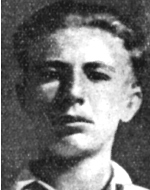Yitzhak, the son of Beshka and Aryeh Leib, was born on February 25, 1931 in Poland, in the town of Lutnia in the Ternopol region, Eastern Galicia (now in Western Ukraine). Only a few dozen Jews lived, but in the entire Ternopol region there were more than 15,000 Jews, a large and active community, and on the eve of World War II the area was annexed to the Soviet Union. Hundreds were sent to forced labor, and a ghetto was established in the city in September 1941. In March 1942, the Aktionen began, The ghetto, in August 1943. The Germans conducted selections in the ghetto: the elderly and sick were slaughtered in the fields near the city, the able and the “efficient” were employed in essential factories in the German agriculture, and the others, including the Jews of the nearby towns, were deported to the Belzec death camp. He was only twelve years old when he joined a Polish partisan company that also hid his Jewishness, hiding with them in the forests and trying to attack the Germans only when the Russians entered the area to discover his origins. At the end of the war, alone and alone, Yitzhak immigrated to Palestine in 1946 on the illegal immigrant ship Haganah. The ship was purchased in Canada by the Haganah’s Mossad Le’Aliyah Bet. On July 25, 1946, she left the port of Bacar, Yugoslavia, on her second voyage to Palestine carrying 2,768 Ma’apilim – members of Zionist movements and refugees from various parts of Europe. After a boatload of technical difficulties, the ship was spotted at sea by a British destroyer, the British sailors stormed the ship and shot the immigrants in the air. A week after their departure, the immigrants were removed at the port of Haifa and transferred to the Atlit detention camp. Yitzhak, who was wounded in the ship during the struggle against the British, was taken to the camp. After a short time he managed to escape and reached the agricultural educational institution in Magdiel. In March 1947 he moved to the vocational school in Safed, where he specialized in fine mechanics. He lived in the Youth Aliyah boarding school. After his difficult years in the war he became a lonely young man who does not trust anyone, and among his friends his age is called “the quiet.” Despite his youth, he became a member of the Palmach in Kibbutz Ayelet Hashahar, the “Yatzivim” training center (currently in Beit Guvrin). He was the first battalion of the Palmach (“Ha’emek”), which operated in the framework of the Yiftah Brigade, the 11th Brigade of the Haganah, and the outbreak of the War of Independence (late 1947) Yitzhak participated in many battles in which he displayed great courage and determination, including taking part in the elimination of gangs of murderers and punitive actions in the eastern Galilee, in the Ayelet Hashahar, Manara, Hulata and the Jordan estuary. Had been besieged and besieged since the beginning of the War of Independence, and all his comrades were mobilized to defend the place. A. On the ninth of Adar I 5708 (February 19, 1948), a convoy left for Manara. In order to protect it, the defenders took control of the road, but on that day the Arabs took advantage of the particularly harsh weather conditions and ambushed the convoy. When it moved away from the Nabi Yosha police station on its way to Manara, the Arabs opened fire, including bullet-proof bullets. The convoy was stopped and many of its passengers were injured. Yitzhak, who was one of the defenders of the convoy, fought fiercely and managed to save the property from loss. ContinuedThe fighting fell, and was one of three killed in the same battle. Seventeen years old in his fall. Isaac was buried in Ayelet Hashahar. On the 27th of Elul 5709 (21.9.1949) he was transferred to eternal rest in the military cemetery in Haifa. This hero is a “last scion”. The survivors of the Holocaust are survivors of the Holocaust who survived the last remnant of their nuclear family (parents, brothers, sisters, sons and daughters) who experienced the Holocaust in the ghettos and / or concentration camps and / or in hiding and hiding in territories occupied by the Nazis and / Or in combat alongside members of the underground movements or partisans in the Nazi-occupied territories who immigrated to Israel during or after World War II, wore uniforms and fell in the Israeli army.
